The internal flora of humans provides an excellent environment for the habitat and active reproduction of microorganisms that belong to the group of pathogens. The types of parasites in the human body are usually divided into two types: those whose presence is not noticeable and has practically no effect on overall health, and those whose presence can be destructive. In the course of their life activity, they can not only negatively affect organs, but also release toxic substances that poison all living things.
General symptoms of infestation
When parasitic eggs or adult parasitic organisms enter the human body, there is an incubation period during which the parasitic infection may be asymptomatic. Signs of ectoparasites are immediately noticeable: allergic rashes, sores and itching appear on the skin. It is more difficult to identify endoparasites; Parasitic diseases often have similar symptoms to other diseases. Primary symptoms are caused by toxins and are often perceived and ignored as a result of overwork. A signal for diagnosis is the appearance of the following symptoms:
- allergic reactions to waste products of parasites;
- Anemia;
- Headache;
- causeless sleep disorders;
- dyspeptic disorders;
- frequent nausea, abdominal pain;
- diseases of the gastrointestinal tract;
- increased body temperature;
- Pain in the liver or enlargement of the organ;
- frequent causeless pain in joints and muscles;
- any long-term conditions that are not related to other diagnosed illnesses.
Types of human parasites
Given the high prevalence of human parasites, it is advisable to know the main types. It is also necessary to understand what symptoms accompany the presence of a particular parasite in the body.
Let's consider the general classification of parasites whose host is humans:
Ectoparasites are dangerous because they are carriers of serious infectious diseases: typhus, encephalitis, anthrax, trypanosomiasis and other diseases.
Ectoparasites that can become infected in exotic countries cause enormous damage to health, so special caution is required when traveling.
The main types of protozoan parasites:
- Giardia leads to the development of dysbiosis, hypovitaminosis, intoxication of the body, dysfunction of the gastrointestinal tract, anemia;
- Amoebas cause intestinal disease and asthenia;
- Toxoplasma can cause diseases of the eyes, brain, heart and nervous system and is particularly dangerous for pregnant women;
- Trichomonas lead to diseases of the reproductive system.
The listed types of protozoan parasites most often infect the human body. Infection with them can be accompanied by severe symptoms or occur without obvious signs.
Helminths are the most common endoparasites, carried by more than 80% of people. These worms live in various human organs and lead to the development of dangerous chronic diseases. In the most severe cases, helminth infestation leads to death.
Types of parasitic worms that affect people of all ages:
Nematodes – this type of worm is commonly diagnosed in children and adults. This is because they can be easily transmitted from person to person or through contact with household items on which worm eggs remain, or by eating poorly washed food. Another name for nematodes is roundworms, since the body of these helminths has a round shape when cut. Their size varies from a few millimeters to tens of centimeters.
There are 45 species of nematodes that can live in the human body. The most common:
- Pinworms are worms up to 1 cm long that live exclusively in the intestines and cause exhaustion, indigestion and sleep disorders;
- Roundworms are dangerous parasites up to 30 cm long that migrate through the body, causing the development of allergies, asthma, anemia and dermatological diseases, and damaging the integrity of organs. Roundworms can develop serious diseases;
- Trichinella worms several millimeters in size, which cause serious health problems: fever, swelling, dermatitis, allergies, stomach problems;
- Whipworms are worms up to 4. 5 cm long that parasitize the intestines, causing anemia, weakness and intoxication.
Trematodes are helminths with a flat shape. Another name for trematodes is fluke. This is because all parasites in this group have suction cups on their bodies that attach them to internal organs, thereby absorbing useful substances, blood and other body secretions.
To parasitize the human body, trematodes must undergo an obligatory developmental phase in the body of an intermediate host. Most often these are fish, so you can become infected with trematodes by eating fish meat that has not been sufficiently heat-treated. The most common leeches:
- Siberian or cat fluke (Opisthorchus) is a 1-2 cm long flatworm that parasitizes in the ducts of the gallbladder as well as the pancreas and liver, causing the development of ulcers, gastritis, pancreatitis, cholecystitis and nervous disorders;
- Intestinal eel (Strongyloid) is a worm up to 2 mm long, the infection of which leads to diseases of the digestive tract, asthma, anemia, allergies, asthenia, bronchitis and infertility.
- Cestodes or tapeworms are a dangerous type of parasite that reaches tens of meters in length. In order to develop, they have to change an intermediate host, which is usually a hoofed animal. Parasite larvae enter the human body when they eat contaminated meat that has not undergone sufficient heat treatment. The main types of tapeworms are: a wide tapeworm several meters long that parasitizes in the small intestine; it provokes diseases such as anemia, intestinal obstruction, digestive problems, asthenia; Pork tapeworm is a worm up to 8 m long, the infection of which leads to intestinal obstruction, cysticercosis and taeniasis; The bovine tapeworm is a parasite up to 18 m long that causes dangerous diseases in humans: anemia, exhaustion, intestinal obstruction, stomach problems, allergies, problems with the nervous system; Echinococcus is dangerous for humans when infected with the larvae of this tapeworm, as they develop quickly when they enter the body and form large tumors.
Trematodes are very dangerous. They spread throughout the body, causing multiple mechanical damage to organs and absorbing large amounts of blood and useful substances.
Classification of types of parasites in the human body
There is a division into true and false parasitism. Cases in which the pest is not considered a human parasite and causes harm when accidentally entering the body are classified as false parasitism. An example are insects and leeches in the nasopharynx or ear canals. Due to the risk of widespread damage and obstruction of the respiratory tract, emergency removal of the pest is necessary. Depending on the type of pest, the treatment of true parasitism is mainly medication.
Ectoparasites
The highest activity of ectoparasites occurs in spring, summer and early autumn. Organisms that parasitize the surface of the skin: lice, ticks, bedbugs, some species of flies, mosquitoes. They damage humans through bites and form colonies in the skin, leading to skin lesions. Ectoparasites pose a serious threat to humans as they are vectors of infections and viruses such as encephalitis, malaria, typhus, plague and anthrax.
Protozoa
This small human parasite consists of a single cell and parasitizes in a variety of organs and tissues. It causes serious, often chronic illnesses. The best known include amoeba, lamblia and toxoplasma. The entry routes of parasites are diverse, mainly through food and water. Some species cause fatal diseases, such as the aquatic amoeba species Naegleria Fowler, which causes primary amoebic meningoencephalitis.
Helminths
A person can be a carrier of many types of parasites. Helminths include species of parasitic worms that live in the internal organs of living organisms. They can be quite large; Parasites living in the body can cause significant damage to tissues and organs and can even lead to death if left untreated. There are the following types of parasites in the body:
- Roundworms, nematodes, range in size from 12 mm (Trichinella) to tens of centimeters (Ascaris). Some species, such as hookworm, penetrate the skin.
- Trematodes, flatworms, are also popularly called leeches because of the suction cups on their bodies. Infection occurs when an invasive form of the parasite enters the body and develops in the body of an intermediate host or in water.
- The largest helminths are cestodes, better known as tapeworms or tapeworms. There are more than 1015 m (bovine tapeworm), and the largest representative, the broadband worm, reaches more than 20 m. The intermediate host and source of infection are usually farm animals.
worms
Everyone knows about these shiny, curly, reddish-gray, tube-shaped earthworm life forms. They are native to Europe, but are now found in large numbers in North America and western Asia.
The earthworm's digestive system is a tube that runs directly from the mouth, which is located at the tip of the front end of the body, to the back of the body. The digested material is transported outside through a special hole and leaves the worm's body.
The species vary in their feeding habits, but generally they eat fallen leaves. By living in the soil, worms can transport nutrients such as potassium and nitrogen, which has a positive effect on soil properties. In addition, the movement of the earthworm creates burrows that facilitate the passage of air and loosen the soil.
What are helminths?
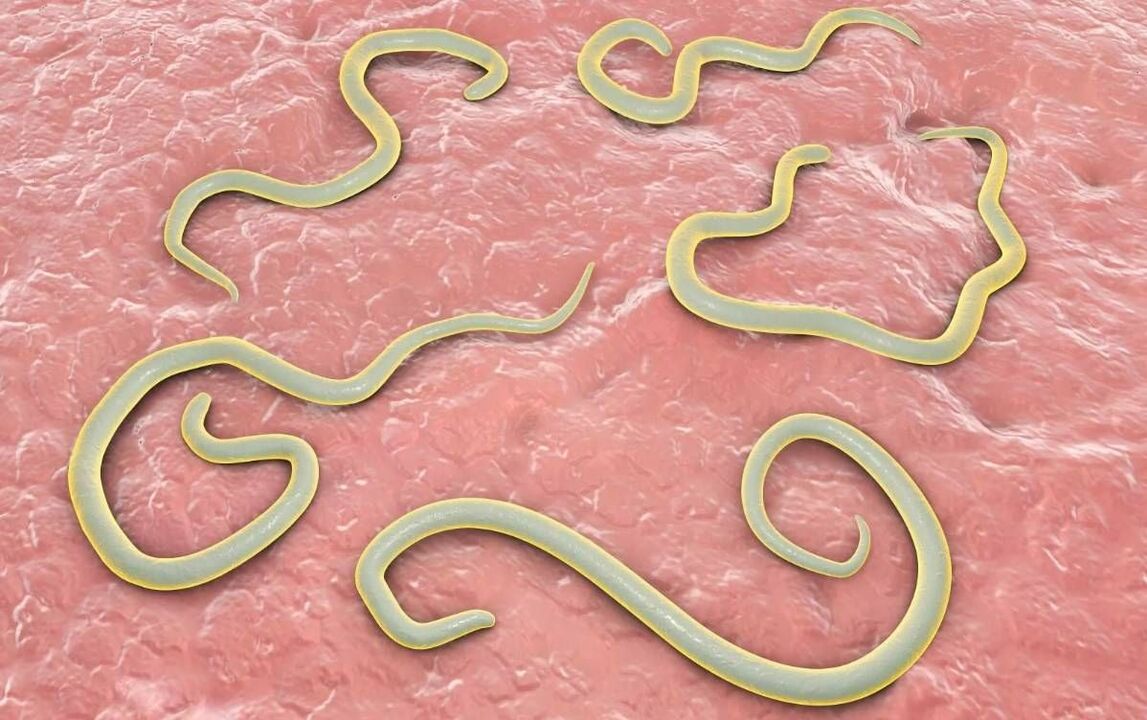
Today, scientists count more than 300 species of various helminthic diseases affecting the human body. Worms are scientifically known as helminths; Infectious disease specialists divide them into extraintestinal and intestinal worms. Depending on the classification of the disease, worms in an adult can be located directly in the intestines or in the liver, lungs and muscles. The most common diseases are ascariasis and enterobiasis.
For information! The presence of helminthic infestation causes oncology and other parasitic diseases.
Enterobiasis
What are the names of the small worms that cause enterobiasis? Enterobiasis is caused by small worms called pinworms. Their length is no more than 1 cm. One part of the worm is pointed and the other is rounded. The color of pinworms can be white, yellow or black. These worms are nocturnal organisms; Worms have been known to crawl out of the anus, where they lay their eggs in the folds and die.
For information! The average lifespan of a pinworm is no more than a month and a half.
Ascariasis
Ascariasis is caused by large roundworms. Large worms can reach a length of up to 20 cm and their lifespan is several years. Such helminths primarily parasitize in the small intestine of adults and children and are therefore difficult to detect in feces.
The most common species
The scabies mite causes itchy skin. Common ectoparasites that live on the skin include the scabies mite, lice that cause pediculosis, and the demodectic mite. In spring-autumn, ixodid ticks appear that live in fields and forest areas and are called encephalitis ticks. Among the protozoa, Giardia, Toxoplasma, Trichomonas, Coccidia, Amoeba, Babesia, Plasmodium and Isospora are the most common types of parasites in humans. Common cestodes include beef and pork tapeworms, as well as the largest broadband worm. Among nematodes, roundworms, pinworms, trichinella and whipworms are often diagnosed. The most common trematodes are Strongyloides, Opisthorchis and Fasciolas, better known as liver flukes and giant flukes.
Pinworm
Another type of parasite that lives in the intestines are pinworms. These are helminths with a length of 3 to 12 mm. Young children are more susceptible to infections from unwashed food and hands and from ingesting worm eggs.
Pinworms
A distinctive feature of this type of helminth is the activity of the female, which occurs at night while the individual is sleeping. She lays eggs around the anus. The child begins to itch and begins to scratch the itchy organ. At this moment, the larvae attach themselves to the baby's fingers and under the nails. Helminths can live under a child's nails for weeks. Re-infection occurs when the fingers in which the larvae live enter the baby's mouth.
You can fight pinworms without the use of medication. It is enough to iron the child's clothes with a hot iron after each nap, dress him in thick underwear to prevent his fingers from coming into contact with worm eggs, and also cut his nails short so that the eggs do not linger therecan. In addition, you need to constantly wash your child's hands with soap. If the use of medication is necessary, prior consultation with a specialist is required.
Trichinae
Trichinae
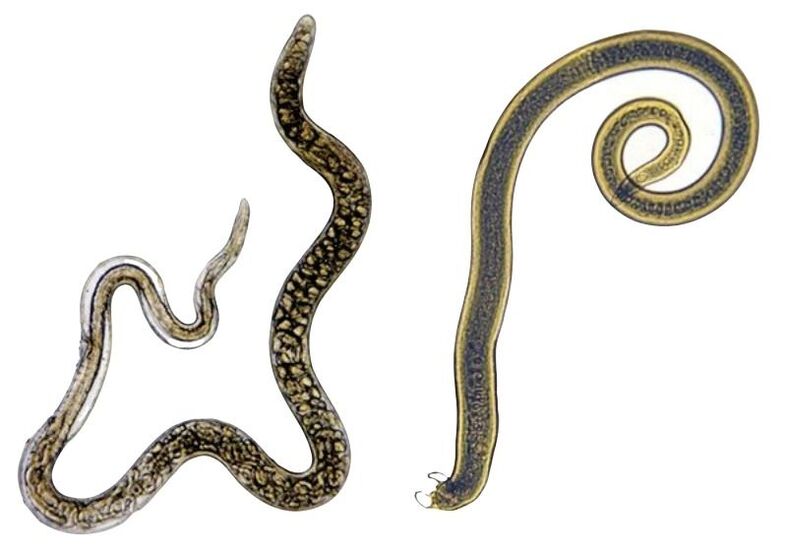
The size of parasitic worms is extremely small, the length of an individual does not exceed 4 mm. They are acquired by eating poorly processed meat that contains worm eggs. Most often it is pork or game meat. After thermal procedures with violations, the raw product can cause infection with these types of helminths.
Parasites can spread very quickly and enter the bloodstream via the intestines. The larvae, which migrate inside the body, attempt to nest in the striated muscles (diaphragm, eye or chewing muscles). When worm embryos get to the desired part of the body, they form a capsule nearby and can live for many years.
Symptoms of trichinella infection are muscle pain, swelling of the eyelids and pain when moving the eyes, increased body temperature, swelling of the face for no reason, swelling of the arms, legs and hands, after a few days the entire muscles of the body and joints already hurt, coordination is slightly impaired, a rash appears on the skin. A person is worried about drowsiness or complete insomnia, persistent headaches, and stomach discomfort.
Tapeworm infections are less common, but also occur in adults and children. Parasites also enter the human body in the larval stage and continue to develop in the intestines.
Chain
The more common name for such parasitic worms is tapeworm. The bull tapeworm is truly huge and can reach a length of 10 m. Small parasitic worm embryos are easily ingested through undercooked or undercooked meat.
The main symptoms of infection are stool disturbances, stomach upset, sudden weight loss, vomiting and loss of appetite. The patient is irritable, suffers from insomnia or sleep disorders and dizziness. Children have a delay in general development.
The pork tapeworm is of a more modest size, reaching only 2 meters in length. The method of infection and the clinical picture are almost the same as above, only people become infected through pork.
Tapeworm
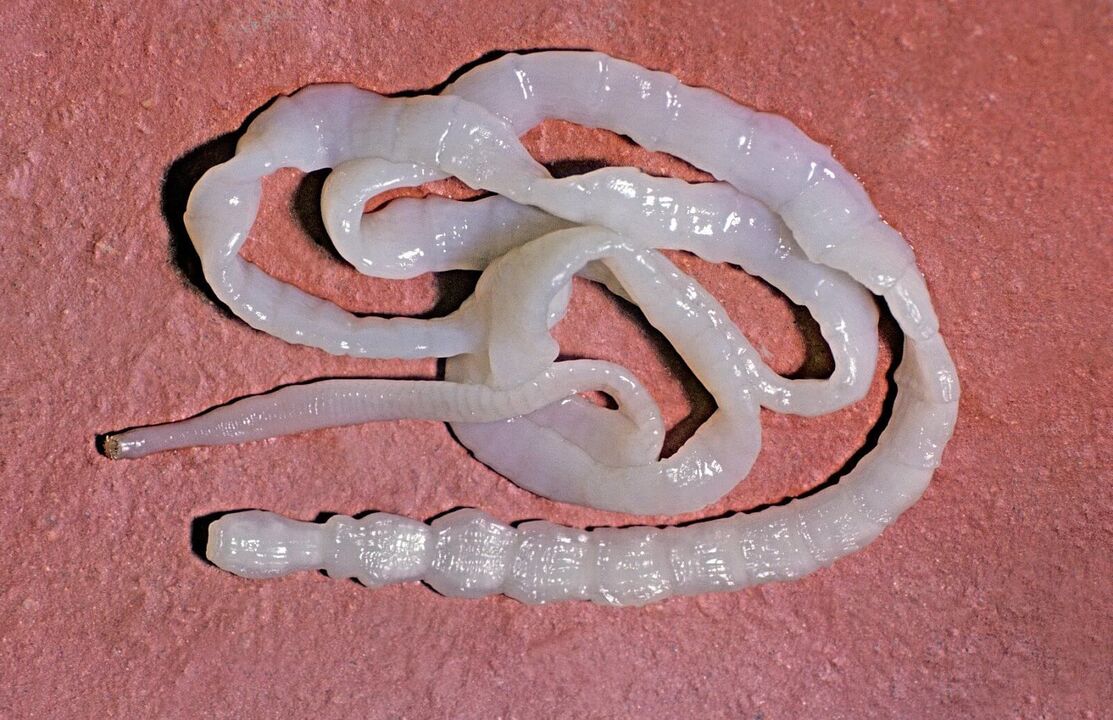
There is another type of tapeworm called the dwarf tapeworm. The name was given to it because of its relatively small size; the largest individuals do not exceed 5 centimeters in length. Unwashed hands are more likely to become infected with parasitic worms. The most common habitats are doorknobs, lids and toilet seats. Children are at risk of becoming infected with the dwarf tapeworm.
After infection with a helminth, the patient experiences abdominal pain, accompanied by nausea, decreased appetite and weight loss. Dizziness is an integral symptom of infection with almost all known helminths. In this case, epilepsy-like seizures are not uncommon.
The broadband worm is also a subspecies of the tapeworm. It has a length of 6 to 15 meters. A person can become infected with helminths through poorly cooked river fish.
A special symptom in this case is red spots on the patient's tongue, which remind him of pain. In addition, an infected person is worried about: vomiting, diarrhea, followed by constipation, constant dizziness and nausea.
Echinococci
Among all types of helminths, special attention should be paid to such a dangerous helminth as echinococci. All medications are powerless against this parasite and the patient can only be cured through surgery. Infection usually occurs through pets with which a person often communicates and strokes.
Entering the bloodstream, the worm can settle in any organ, establish itself and parasitize inside. The parasite forms a capsule next to itself, which is filled with a liquid composition. He lives there himself and lays out larvae. During the operation it is extremely important to remove this along with the intact capsule. Otherwise, all organs that receive fluid from the capsule will be infected.
Giardia
Giardia through a magnifying glass
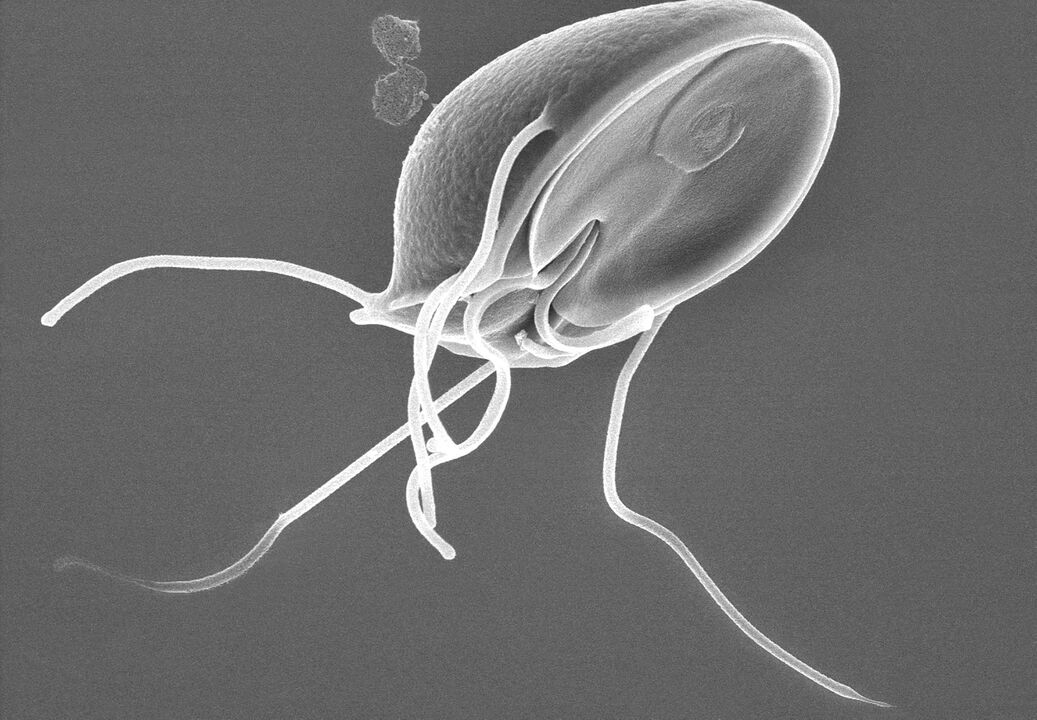
Another type of helminths that is often found in medical practice. If hygiene regulations are not observed, larvae can enter humans through the fecal and oral route.
The small intestine becomes the home of the worm. The main symptoms of infection are constant abdominal cramps, nausea, stool disturbances, indigestion and excessive gas formation. Patients also suffer from nervous disorders, poisoning and allergic reactions.
To defeat worms inside humans, antiprotozoal drugs are used, as well as enzymes, choleretics and enterosorbents.
The group of leeches is represented by flatworms, which often affect humanity. Fasciola is the most prominent member of the group, Fluke is no less popular.
fluke
Parasitic worms are small, reaching 413 mm in length. It penetrates inside a person and lodges in the gallbladder or bile ducts. The worm gets inside through improperly cooked frozen or raw river fish.
The clinical picture of an accidental infection is manifested by the following signs:
- the temperature rises and lasts for a very long time without responding to medication;
- painful manifestations in joints and muscle tissue;
- Cough;
- Skin rash;
- digestive disorders;
- possible jaundice;
- Pain in the pancreas.
fluke
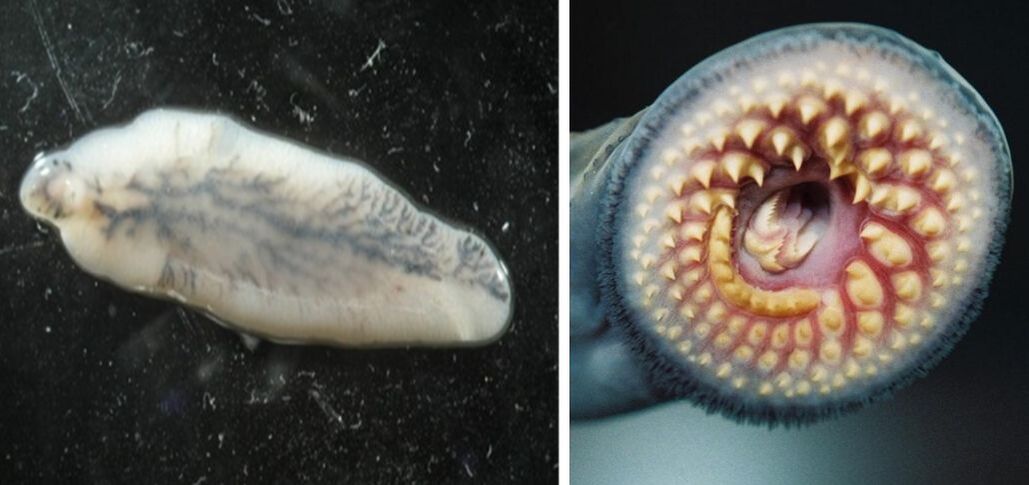
The complications of infection with this type of helminth can be very serious. Therefore, at the first symptoms of infection, you should immediately consult a doctor. After conducting appropriate examinations and tests, he will prescribe effective drugs that can fight parasitic worms and expel them from a person.
Fasciola
The gallbladder and bile ducts of this organ can become home to helminths. The parasitic worm reaches a length of 37 centimeters. You can become infected through unboiled water or eating raw seaweed.
The symptoms of the disease are almost normal: frequent dizziness, fatigue and malaise, urticaria. The stomach hurts badly and jaundice develops. The disease can take a chronic course.
Schistosoma
Another representative of the fluke group, a very dangerous species of helminth, is the schistosome. You can easily become infected in a pool or natural body of water while swimming, but also after watering garden beds with water contaminated with larvae. Whole skin and mucous membranes cannot stop the insidious worm; it can enter and pass through the body.
The disease caused by parasitic worms is manifested by itchy skin and increased temperature. The chronic stage of the disease can be a complication of such an infection. The worm can cause prostatitis in men, as well as vaginitis, colitis, ascites and other diseases.
Therapy uses strong antiparasitic medications that paralyze or destroy parasitic worms, thereby facilitating natural elimination from the body. In particularly advanced cases that are aggravated by complications, the surgical method is used.
Remedies to restore the body after eliminating parasites
In any case, parasites, through their presence, disrupt the normal functioning of the organs in which they are located.
Echinococci calcify in the kidneys and liver, roundworms penetrate the lungs and liver and persist even after death, tapeworms damage the intestinal walls with their suckers, which increases the risk of stomach and duodenal ulcers.
Therefore, traditional medicine recommends using the following recipes to eliminate these consequences:
The intestines are restored by an infusion of flax seeds. The seeds are brewed with boiling water at the rate of one tablespoon per glass and left for 2 hours. Course of treatment: three times a day, 50 ml for a week.
A general recovery is achieved through the following collection:
- nettle leaves 2 parts;
- rose hips 1 part;
- Rowan fruits 5 parts.
The mixture is brewed with boiling water in the same proportion as in the previous point and used in the same way.
Prevention of parasite infestation
Rule No. 1: You cannot eat fish that is not sufficiently salted, fried or boiled. Sushi, salted herring or sashimi can be considered gourmet food. But essentially it is raw fish, and fish is one of the parts of the life cycle of parasitic worms.
How everything happens: first the larva penetrates the mollusk, where it does not grow beyond a certain limit, then the mollusk is eaten by a fish, the larva enters its digestive tract, remains alive, then grows and reproduces and entersinto the digestive tract muscle tissue of the fish, then this fish is eaten by a dolphin, a seagull or a polar bear. Or a restaurant-goer who decides to join Japanese high culture.
Theoretically, there is safe raw fish. To do this, it must either be frozen immediately after being caught and thawed before cooking, or it must be specially bred in a fish farm where the absence of parasites is controlled. But it is usually impossible to check whether a risky dish was actually prepared from it.
The same caution should be exercised with meat; do not try raw minced meat or freshly salted lard.
In order not to become infected with helminths, vegetables and hands should also be washed before consumption. As part of the natural environment, these parasites are almost ubiquitous in the human body.
Any contact of food or hands with soil, soil dust and vegetation can leave microscopic eggs on the food. When they enter the intestines, the eggs hatch into worms that are not easy to remove.
There are parasites that attack a person simply passing by or relaxing in nature, such as:
- Malaria plasmodium, contained in the saliva of mosquitoes of the genus Anopheles,
- the causative agent of encephalitis contained in the saliva of ixodid ticks,
- Gadfly and Wohlfarth fly.
Their prevention involves the use of all types of repellents when hiking in the wilderness, as well as maximum protection of exposed areas of the body (fly nets, nets, special gel).
In conclusion, compliance with simple rules of hygiene and hygiene, as well as the destruction of flies and cockroaches, can significantly reduce the risk of parasitic infection, which entails serious consequences.























